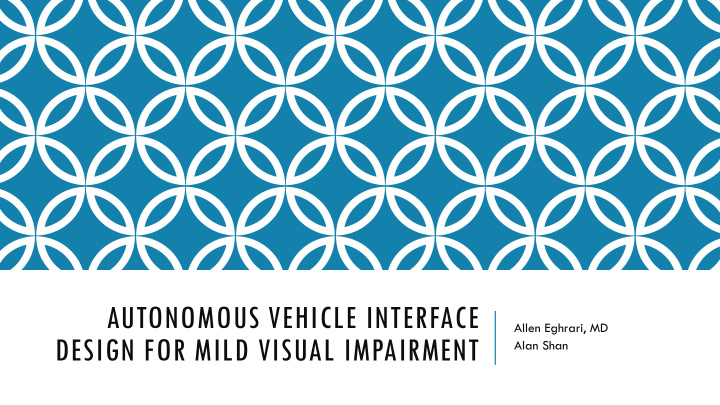



AUTONOMOUS VEHICLE INTERFACE Allen Eghrari, MD DESIGN FOR MILD VISUAL IMPAIRMENT Alan Shan
DISCLOSURES The authors have no financial conflicts of interest to disclose
Visual acuity and requirements for driving Promise of autonomous driving in the setting of visual impairment OVERVIEW Current status of user interfaces in autonomous vehicles Recommendations
What most people see at 70 feet, you need to stand 20 feet away to see What most people see at 20 feet, you can see at 20 feet
VISUAL ACUITY REQUIREMENTS IN THE STATE OF MARYLAND Unrestricted driver’s license: Restricted license: Visual acuity of at least 20/70 in one or • Binocular vision both eyes • Visual acuity (Snellen) of at least 20/40 A continuous field of vision of at least in each eye 110 degrees, with at least 35 degrees • A continuous field of vision of at least lateral to the midline of each side 140 degrees (Requirements must be simultaneous.)
VISUAL FIELDS 110 degrees http://veterinaryvision.com/wp-content/uploads/2012/06/vision1.jpg http://www.vision-and-eye-health.com/visual-field.html https://eyeternus.wordpress.com/tag/visual-field/
110 degrees
1801 drivers age 65 to 84 120 (6.7%) involved in crash during 2-4 year observation interval Glare sensitivity and visual field loss were significant predictors of crash involvement
IMAGE ANALYSIS Each image was graded by 3 separate graders Size of characters measured by pixels using GIMP 2.0 software Measurements averaged across graders and extrapolated to nearest levels of visual acuity
Minimum Visual Acuity Required (Snellen) to visualize indicator: 2013 Model S Dash Object @ 14 in @28 in @36 in @42 in Current Speed 20/400 20/200 20/175 20/150 (mph/kph) “MPH/KPH” 20/60 20/40 20/25 20/20 Power (kW - the 20/70 20/40 20/30 20/25 number) Odometer: 20/80 20/50 20/40 20/40 Drive mode (P, R, N, D) 20/80 20/50 20/40 20/40 Time (2:38pm) 20/80 20/50 20/40 20/40 Temperature 20/80 20/50 20/40 20/40 Range 20/80 20/50 20/40 20/40 Battery length 20/400 20/200 20/175 20/150 Battery width 20/80 20/50 20/40 20/40
Minimum Visual Acuity Required (Snellen) to visualize indicator: 2017 Model X Dash Object @ 14 in @28 in @36 in @42 in Current Speed 20/400 20/200 20/175 20/150 (mph/kph) “MPH/KPH” 20/70 20/40 20/30 20/25 Max speed 20/100 20/50 20/40 20/40 “Max” 20/40 20/20 20/15 20/15 Steering wheel icon 20/400 20/200 20/150 20/150 Temperature 20/70 20/40 20/30 20/25 Range 20/70 20/40 20/30 20/25 Next street on gps 20/70 20/40 20/30 20/25 Distance to next street 20/63 20/30 20/25 20/20 on GPS Street names on GPS 20/63 20/30 20/25 20/20 Lane line width 20/30 20/15 20/13 20/10
DESIGN ELEMENTS FOR ELDERLY DRIVERS Elderly had better driving performance in high contrast of size and no color Color reduced legibility Addition of color and low contrast of size resulted in significantly longer gaze dwell- on time (2.65 seconds longer in a driving task) With autonomous driving, is gaze dwelling less of an issue?
CONCLUSIONS For individuals with mild visual impairment who are able to legally drive, autonomous vehicles offer the potential for increased safety User interfaces must be optimized to allow this segment of drivers to maximally benefit from the opportunities afforded by autonomous driving Recommendation: “Accessibility mode”? How interfaces are utilized by elderly in autonomous vehicles may vary, but can be edited with updates
ACKNOWLEDGEMENTS Grading team Alan Shan Gelareh Vakili Ryan Meshkin Marjan Tofigh
Recommend
More recommend